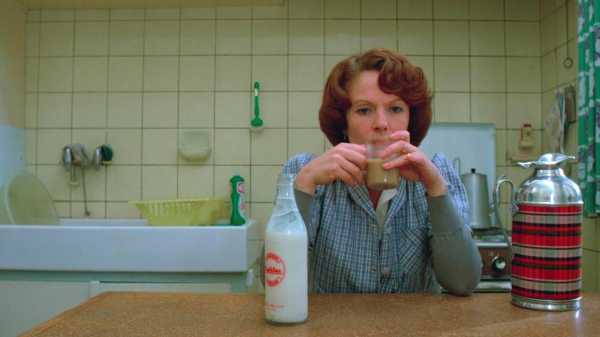
On December 1st, the British Film Institute and Sight and Sound magazine announced the results of their decennial “Greatest Films of All Time” poll—a major event for movieheads. At the top: “Jeanne Dielman, 23, quai du Commerce, 1080 Bruxelles.” It was a long shot—if Ladbrokes had Sight and Sound odds, it might have predicted “2001: A Space Odyssey” or “Tokyo Story” or last decade’s champion, “Vertigo,” in the top spot. The late Chantal Akerman, the Belgian director of “Jeanne Dielman,” is the first female filmmaker ever to crack Sight and Sound’s top ten; Akerman was just twenty-four years old when the movie premièred at Cannes, in 1975. It is a rigorous, uncompromising film, nearly three and a half hours long, depicting three days in the life of the widowed single mother named in the title (played by Delphine Seyrig), and focussed relentlessly on the domestic tasks that occupy her waking hours: the cooking and cleaning, the wiping and straightening and scrubbing. Jeanne is also a sex worker, hosting a client in the late afternoon each day, although these assignations are—unlike the other tedious labor that she performs—mostly unseen. The Sight and Sound tabulations are a striking turn of events, representing a consensus that one of the pinnacle films ever produced in an overwhelmingly male-dominated art form was made by a young woman, with a crew mostly made up of women, starring a middle-aged woman, about women’s work.
The quasi-popular triumph of “Jeanne Dielman” (Sight and Sound’s poll drew on ballots from more than sixteen hundred critics, academics, and film programmers) is surprising, heartening, even humorous. (The image of the more Marvel-minded corners of Film Twitter seeing the poll results over the weekend and cranking up “Jeanne Dielman” on their laptops happily evokes the episode of “The Simpsons” in which an excited little gang of fourth-grade boys hatch plans to sneak into an R-rated movie, chanting “Barton Fink! Barton Fink!”) Especially fun was the inevitable grumping from old white guys, most charismatically the director Paul Schrader, who declared, on his Facebook page, that, although “Jeanne Dielman” is a personal favorite of his and “a landmark film,” its shock appearance at No. 1 “does it no favors,” mutating Akerman’s achievement into “a landmark of distorted woke reappraisal.” Schrader wrote, “It feels off, as if someone had put their thumb on the scale. Which I suspect they did.”
It seems beyond doubt that the feminist (or “woke,” I guess) politics ascribed to “Jeanne Dielman” are part of why it won, and part of its monumental renown. It appeared in the same year as Laura Mulvey’s watershed essay “Visual Pleasure and Narrative Cinema,” which defined the controlling “male gaze” of the movies and permanently altered the lens through which generations of filmgoers and directors saw women onscreen. That “Jeanne Dielman” knocked the ultimate male-gaze movie by the ultimate male-gaze director—Alfred Hitchcock’s “Vertigo”—out of the top position may appear too on-the-nose to an anti-woke conspiracy theorist such as Schrader. But the film’s critical reputation is not a post-#MeToo phenomenon; it has been surging for decades. (So has Akerman’s: her 1976 film “News from Home,” which draws on letters to Akerman from her mother, also made the Sight and Sound list.) In 1976, the critic Louis Marcorelles, writing in Le Monde, deemed “Jeanne Dielman” “the first masterpiece of the feminine in the history of the cinema.” J. Hoberman called it “one of the key artworks of the twentieth century,” “a unique spectacle as well as a strong statement on women’s assigned roles and designated space.” My colleague Richard Brody hailed it as a “tour de force of cinematic modernism,” one that “puts time onscreen as it was never seen before.” The film has explicitly influenced the work of directors including Todd Haynes, Gus Van Sant, and Céline Sciamma, who has said that Akerman is “one of the most important filmmakers in the history of cinema.” Jeanne Dielman herself, as embodied by the impossibly elegant Seyrig, is as emblematic as Maya Deren in “Meshes of the Afternoon,” or Seyrig herself in “Last Year at Marienbad,” of a certain kind of slow, obscure, demanding art-house or avant-garde cinema; in recent years, Jeanne has even become meme-able. Unless there is a hive of Akerman fanatics at Sight and Sound who fixed the vote, the film’s ascension in the rankings (it was thirty-sixth in 2012) can be ascribed to a wider film culture catching up with the longtime views of hard-core cinéastes, as well as a general and welcome broadening of the categories of human experience, labor, and behavior that are deemed worthy of artistic treatment.
The news of the triumph of “Jeanne Dielman” was, in short, pleasurable. “Jeanne Dielman” itself is not pleasurable, or at least not in any obvious or easy sense. The film’s strength derives in significant part from its austerity, patience, and extreme discipline. Each scene consists of a single, fixed shot, placed a bit lower than the norm. (Akerman was five feet tall, and set up her shots accordingly.) The camera does not move; there are no reaction shots and no closeups. Seyrig is onscreen nearly every minute, usually performing some mundane task in real time: washing dishes, making a bed, peeling potatoes. (Just as I never chop garlic without thinking of Paul Sorvino in “Goodfellas,” I never peel a potato without thinking of Seyrig in “Jeanne Dielman.”) More than four minutes are filled by Jeanne taking a bath and then scrubbing out the tub. Well over five minutes pass as Jeanne and her teen-age son, Sylvain, silently eat a dinner of soup, pot roast, and potatoes. Occasionally, Jeanne leaves her apartment to pay a bill or do a bit of shopping. She reads a letter from an aunt; she chitchats with this neighbor and that one. There is no score, just a bit of radio in the evenings.
As the minutes and hours pass, Akerman rewards the viewer’s attention by recalibrating it. It is now attuned to the cracks that begin to appear in the latticework of Jeanne’s regimented day: a missed button, a stray lock of hair. She drops a utensil; she forgets to replace the lid of the tureen where she keeps the cash that her clients pay her. Humdrum routines and banal gestures take on meaning; the setting and tasks remain the same, yet an invisible gas of apprehension, then dread, pervades the scene. (This dread comes to fruition in the film’s next-to-last shot.) Seyrig, who is regal and tinted with glamour even when clad in a seafoam-green housecoat, has an amazingly expressive and open face, conveying mysterious depths of emotion and experience in ostensible repose. She also represents a brilliant feat of intentional miscasting. “She was not this character at all—she was quite the grande dame,” Akerman said in a 2009 interview with Criterion. But if Jeanne Dielman did not have the looks and bearing of a movie star, the director explained, “we wouldn’t really see the person, just as men don’t see their wives doing dishes.” Akerman intended, she said, “to give a cinematic life to all of these actions” that are typically devalued. By casting a beautiful, magnetic star in a dreary, repetitive role, Akerman makes a concession to conventional movie expectations even as she defies them. (A similar yes-but-no dynamic is at work in the Eros-and-Thanatos climax of the film.)
“Jeanne Dielman” is Akerman’s tribute to her mother, to her countless hours of care, and, beneath the surface, to the religious rituals of Akerman’s Polish-Jewish family, many of whose members were murdered in the Holocaust. (Akerman’s mother survived Auschwitz; her mother’s parents did not.) In the observant Jewish home of Akerman’s paternal grandfather, “every activity of the day was ritualized,” a discipline that “keeps anxiety at bay and brings a kind of peace,” Akerman told Criterion. Her mother, she suggested, sought out the same steadying rhythms in homemaking. With this biographical context in mind, even the simple dinners that Jeanne prepares for Sylvain become freighted with terrible history and memory. (Akerman told the Jewish Chronicle in 2008 that her mother, having endured starvation, constantly worried that young Chantal wasn’t eating enough.) In “Jeanne Dielman,” it remains ambiguous whether the repetitiveness and routinization of Jeanne’s life erode her sanity, or if, rather, it’s the lockstep structure of her days that wards off darker thoughts and impulses.
The experience of watching “Jeanne Dielman” is multisensory in an occasionally almost overwhelming way; sit long enough with a woman as she scours a tub and you might begin to smell the Ajax. Jeanne, ever frugal, flips the lights on and off as she enters and exits the few rooms of her cramped apartment, and, over time, this on-off routine takes on a rhythm, a musical syncopation. The clicking of Jeanne’s heels on the floor, the jangling of her silverware, the clackety-fwip when Jeanne replaces the lid of the tureen—these sounds develop a texture, a thing-ness that uncannily situates the viewer in a palpable three-dimensional space. It’s a movie that one continues to metabolize well after it’s over: I rewatched it, on my laptop, after the poll results were announced, and later, making dinner, I felt unusually interested in the tone of the knife as it hit the cutting board, the precise choreography of the dishrag swirling over the countertop. A later scene in “Jeanne Dielman,” in which Jeanne repeatedly folds and flattens, folds and flattens, folds and flattens a raw meatloaf, seems especially dilated, the squish-squish sound of the eggy ground beef oozing into an especially touchy spot in the human ear canal. And a scene quite close to the end, in which Jeanne inadvertently upsets an infant, and then proceeds to torment the screaming child, is straight out of a horror movie.
In fact, one aspect of “Jeanne Dielman” that it shares in common with both comedies and horror movies—with most movies, really—is that it is ideally experienced with an audience, where individual emotional responses collide, cohere, and compound one another. The movie is occasionally quite funny, whether in Jeanne’s dry ripostes to Sylvain’s drippy monologues or in the endless scene in which Jeanne fastidiously fails to prepare herself an adequate cup of coffee. Some twenty years ago, when I first watched it at a repertory theatre, as the minutes ticked by on Jeanne and Sylvain eating their pot roast, a guy two rows ahead of me started laughing helplessly, setting off a wave of giddy contagion through the rest of the audience, along with scattered shushing. I don’t know why that guy started laughing, but I would guess it had something to do with the absurdity of a hundred or so people sitting quietly in rows watching a teen-ager eat pot roast. “Jeanne Dielman” can be intensely, maddeningly, and hilariously boring; with an audience, though, you can share your boredom with others, which makes the boredom more interesting, turning it into a meta-boredom—a boredom you can turn in the light and examine from multiple angles. This boredom—a boredom firmly fixed in space, time, and intention—is entirely different from the boredom I feel watching the strobing, spatially incoherent, slice-and-dice montage that dominates much of contemporary cinema, from franchise blockbusters to Academy Award winners for film editing. One permits you to think, even insists that you think; the other obliterates thought.
I suspect that the Sight and Sound voters who truly love “Jeanne Dielman,” as opposed to merely admiring it (I am in the latter camp, for whatever it’s worth), are those who can enter a meditative state when watching it, who can dissolve their ego into the folds of Jeanne’s shirtdress during the many minutes that we spend watching her from the back as she washes dishes. Meditation is often accomplished through a focus on one’s breathing, and so it’s apt that an especially suspenseful and doom-laden moment in “Jeanne Dielman” comes on the ominous third day, in a shot of Jeanne simply sitting in a chair in her living room—not knitting or folding or smoothing, just sitting, and Akerman and Seyrig draw us toward the variations and tiny irregularities of Jeanne’s breathing. With each shallow inhalation, one expects something momentous to happen. This is part of the great project of “Jeanne Dielman,” and why so many cinéastes treasure it so fiercely. It sought to redefine everything that makes a film a film: how it establishes tension and tempo, how it defines or disregards plot, whom it chooses as a protagonist. One can watch “Jeanne Dielman” and wait for something to happen, but it already is. ♦
Sourse: newyorker.com






